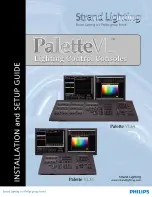
JesterML Operating Manual
Glossary
54 of 65
73-406-00 Issue 1.0
paged, with the current page being shown on the 7-segment displays above the
Page Up/Down buttons.
MSD
Mass Storage Device. See
Flashdisk
.
Mode
The button which defines which mode the JesterML is in.
Modifiers
The options available within a chase: Attack, Direction and Speed.
Non-Isolated
The DMX512-A output port on the back of the JesterML is
not
isolated. Conversely,
the DMX512-A input port on the back of the JesterML is opto-isolated. This is the
preferred grounding topology of the DMX512-A standard.
Notes
Part of the MIDI system, whereby a specific note can trigger a memory or submaster.
Numeric Entry
The JesterML allows you to use the Multi-Function-Keys (and submaster flash
buttons on the JesterML24) to enter numbers into the desk, where appropriate.
Offset
The time shift that is applied to a
Movement Effect
from it’s reference. The offset of
a Movement Effect is controlled by the wheels when the appropriate POSITION
wheel group is selected for a fixture with Pan & Tilt.
Output
A single channel, which is controlled by the JesterML.
Page A/B
The PAGE A and PAGE B buttons allow you to switch the function of the preset
faders.
Page Up/Down
The PAGE UP and PAGE DOWN buttons allow you to select the page for the Multi-
Function-Keys. The current page is indicated on the 7-segment displays above the
buttons. These buttons are not used when CHASES or SPECIAL are selected, since
only one page of options is available.
Palette
Palettes are small bits of memory which can be used as building blocks for your
show. They are stored under Colour, Beamshape or Position and are located on the
Multi-Function-Keys. There are 30 of each available, giving you plenty of room to
store commonly used colours, positions and beamshape looks to palettes as
required. Palettes are useful both for busking a show using easily accessible pre-set
Содержание Jester
Страница 1: ... OPERATING MANUAL ...












































